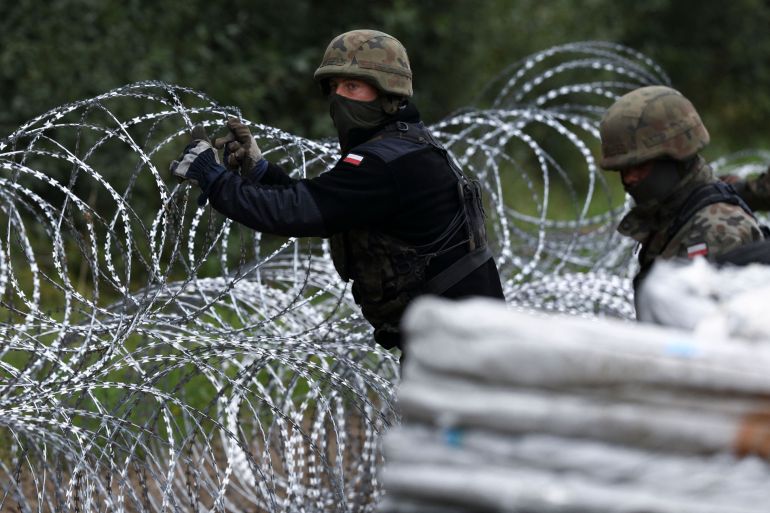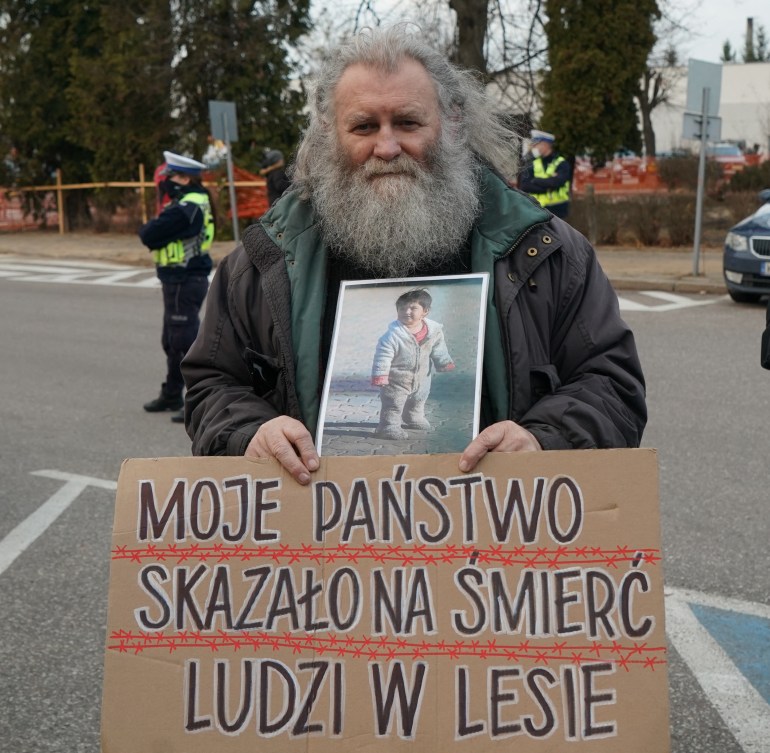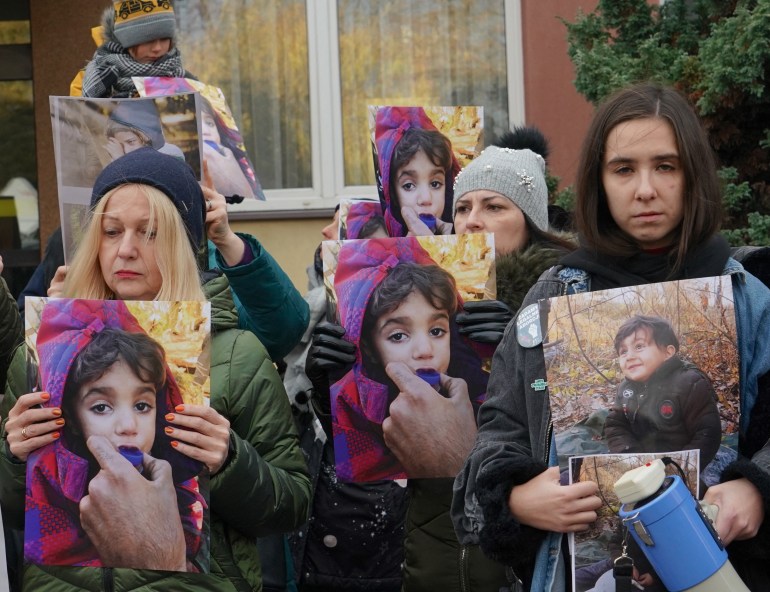How Poland influences opinion over the Belarus border crisis
Migrants are viewed as dangerous invaders as pop concerts laud border guards and right-wing media prints scare stories.

Krakow, Poland – On December 5, Minsk Mazowiecki, a town of 40,000 people less than 60km from Warsaw, hosted some of Europe’s most famous one-hit wonders.
Standing on stage at an airbase, between a fighter jet and a helicopter, Lou Bega of Mambo No 5 fame, Captain Jack, In-Grid, Luna, and Edyta Gorniak, a Polish pop singer who has become the face of the so-called “anti-vaxx” movement, among others, belted out their biggest hits to support those, who in their view needed them most: Polish soldiers and border guards protecting Europe’s easternmost front line.
Keep reading
list of 4 itemsPoland: Concerns grow for missing four-year-old refugee girl
Is Poland violating international law at its border?
What next for the refugees stranded between Belarus and Poland?
“Thank you for what you do,” said Captain Jack.
“Greetings to Polish soldiers!” said In-grid, in Polish.
Las Ketchup, a Spanish band known for their 2002 hit Asereje, could not make it to Poland because its members were summoned for quarantine.
Three million people watched the concert on television, a significant number in the country of 38 million. Foreign artists sang their biggest hits while Polish singers also offered some patriotic numbers.
“Polish Army soldiers greatly appreciated the concert. We would like to thank everyone who attended the event or watched it on TV because they proved that the Polish nation stands behind the Polish uniform,” Mariusz Błaszczak, Poland’s defence minister, told the state broadcaster.
“When they feel that their actions are supported, they feel stronger.”
Over the past four months, Polish soldiers have been mobilised at the Belarus border in huge numbers to repel refugees and migrants trying to enter the European Union.
Those who manage to breach the barbed-wire fence often end up wandering through the Polish woods near the frontier, with little or no access to clean water, food and shelter, as they hide from authorities who want to stop them travelling deeper into the country. People found in the woodlands covering the borderland are not allowed to claim asylum.
The refugees’ only hope for survival in the winter cold has been NGOs and locals who have mobilised to address the growing humanitarian crisis. But even this is challenging, as Poland has severely restricted access to the border zone for activists.
Meanwhile, both Polish and Belarusian authorities stand accused of abuse. Polish pushbacks of asylum seekers to Belarus, where people are reportedly beaten by Belarusian guards and forced to cross the border again, has been a norm.

Warsaw and its Western allies hold Minsk responsible for the deteriorating situation, claiming that the Russia-allied country is trying to destabilise Europe.
Critics say Belarus encouraged people to try and enter Europe as a revenge act against the West, which supported last year’s protests against longtime Belarusian President Alexander Lukashenko.
At least 19 people have died trying to cross the border, but the real numbers might be higher. Night temperatures in the woods have fallen below 0 degrees Celsius (32 degrees Fahrenheit).
The nationalist Polish government, as well as state and right-wing media, do not present the situation at the border as a humanitarian catastrophe.
Those tasked with pushing the refugees back are portrayed as national heroes and the situation at the border as an act of Belarusian aggression against Poland.
While NGOs and locals living in the restricted zone have gathered food, warm clothes and sleeping bags for asylum seekers shivering in Polish forests, other locals provide snacks and food for the soldiers protecting the border.
Last week, President Andrzej Duda and First Lady Agata Kornhauser-Duda attended a charity concert in Bialystok’s Opera and Philharmonics in support of ill children of border guards. Banners expressing gratitude to Polish officers protecting the border are scattered across the border.
In the current discourse, asylum seekers are seen as invaders and agents of Lukashenko.
In late November, the Polish right-wing weekly Sieci warned on its cover – “Just like a front line, just like war.”
“Pieces of wood, firecrackers, stones and bottles are thrown at the defenders of Polish borders. Migrants and Belarusians blind them with lasers, shoot with a slingshot, plant bomb mock-ups,” the cover said. “Twenty people have been wounded.”
In this view, Poland is a force of good, defending European borders from the “other”, and migrants are a force of evil. Lukashenko and his political patron, Russian President Vladimir Putin, are the masterminds.
Experts see the narrative as an attempt to dehumanise asylum seekers, which in the history of propaganda, has been a first step to making violence justifiable, if not necessary.
“The easiest way to introduce propagandistic mechanisms has always been imagery. And in this case, the imagery appeared naturally – it’s a war. There are ‘Us’ – the good ones, who are forced to act by ‘Them’ who are against us, jeopardise our security, health, life and wellbeing,” said Pawel Nowak, professor of media and communication at Maria Curie-Skłodowska University.
“Asylum seekers are presented as a group, not individuals. It’s a fight against someone who doesn’t deserve to be called a human, it’s a danger, a disease. A threat of war is very good in terms of propaganda. The government is spreading fear so that people are afraid of refugees but do not panic. Thanks to that, it effectively manages the crisis propagandistically and controls its public perception.”
The official narrative has pleased a right-wing audience.
But as Nowak observes, a main feature of propaganda is that it convinces the convinced.
On the other side of the political spectrum, NGOs, experts and artists have joined efforts to present a different side of the story.
Singers and actors recorded songs to shed light on the human tragedy unfolding at the border. A song produced at the initiative of Lena Piekniewska-Bem, a Polish singer and actress, focuses on the imagery of those stuck in woodlands:
“A forest wanted to be a forest only, nothing else
“But it became a shelter, a fear, a curse
“Don’t be afraid, forest, the world will remember
“You did all you could have done
“Moss on the hearts.”
